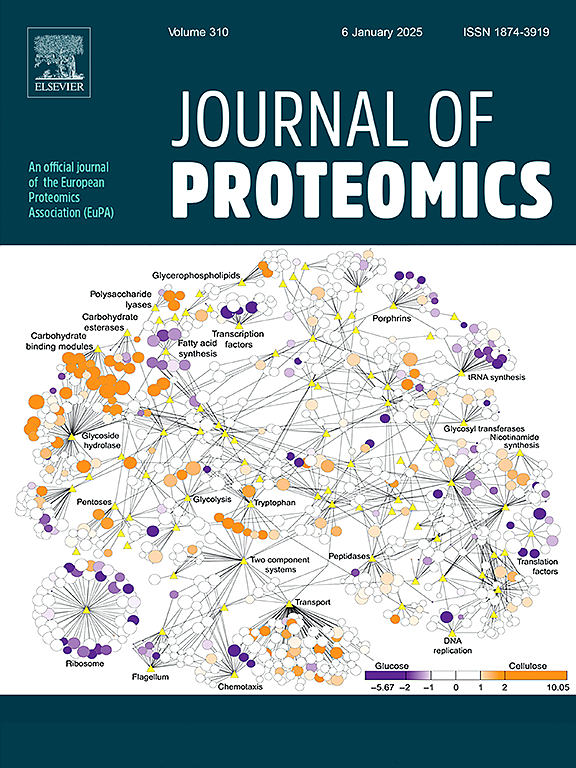Comparative secretome analysis of Oudemansiella raphanipes grown on different agricultural residues
IF 2.8
2区 生物学
Q2 BIOCHEMICAL RESEARCH METHODS
引用次数: 0
Abstract
Oudemansiella raphanipes can degrade lignocellulose-rich biomass, especially agricultural residues. However, its substrate utilization and degradation mechanisms remain poorly understood. To explore this, we cultured O. raphanipes mycelium in Kirk's liquid medium supplemented with eight distinct substrates and conducted studies on extracellular enzyme activities and secretome analysis. A total of 905 secreted proteins were identified, with the cornstalk group having the highest counts. Carbohydrate-active enzymes (CAZymes) were the predominant type (32.8–48.9 %), followed by oxidoreductases (2.8 %–13.3 %), while lipase and phosphatase were minor categories. Functional annotation of the secreted proteins comprehensively revealed their diversity in various biological processes. Among the 340 secreted proteins with Enzyme Commission codes, (Methyl)glyoxal oxidase, chitinase, and β-glucosidase were most prominent. Bran, cottonseed hulls, corncobs, and the mixture promoted mycelium growth and conserved CAZymes expression patterns. In contrast, sawdust, corn steep liquor, and cornstalk induced divergent secretome profiles. Sawdust led to a higher proportion of hemicellulose- and lignin-degrading enzymes. Corn steep liquor induced relatively high activities and abundances of laccase and MnP, while cornstalk induced a broad spectrum of oxidoreductases, lipases, and protease & peptidases. In addition, redundancy analysis further indicated that the extracellular enzyme activities (notably laccase, MnP, and xylanase) induced by different substrates significantly impacted the secretome.
Significance
O. raphanipes can efficiently utilize a variety of lignocellulosic materials, and genomic sequencing has confirmed the presence of abundant CAZymes in its genome. This study employed various agricultural residues as substrate inducers to elucidate the extracellular enzyme profiles of O. raphanipes involved in lignocellulose degradation, which indicated its metabolic plasticity in response to varying substrate composition. These findings facilitate further exploration of the biomass bioconversion mechanism of O. raphanipes and provide novel perspectives for the induction of combined agro-residues in its industrial cultivation.

不同农业残留物上生长的raphanipoudemansiella的分泌组比较分析
raphanipes Oudemansiella可以降解富含木质纤维素的生物质,特别是农业残留物。然而,其底物利用和降解机制仍然知之甚少。为了探究这一点,我们将O. raphanipes菌丝体培养在含有8种不同底物的Kirk’s液体培养基中,并进行了细胞外酶活性和分泌组学分析研究。共鉴定出905种分泌蛋白,以玉米秸秆组最多。碳水化合物酶(CAZymes)是主要类型(32.8 ~ 48.9%),其次是氧化还原酶(2.8% ~ 13.3%),脂肪酶和磷酸酶是次要类型。分泌蛋白的功能注释全面揭示了其在各种生物过程中的多样性。在340个具有酶委员会编码的分泌蛋白中,(甲基)乙二醛氧化酶、几丁质酶和β-葡萄糖苷酶最为突出。麸皮、棉籽壳、玉米芯和混合物促进菌丝生长,并保持CAZymes的表达模式。相比之下,木屑、玉米浸泡液和玉米秸秆诱导不同的分泌组谱。木屑导致高比例的半纤维素和木质素降解酶。玉米浸泡液诱导的漆酶和MnP的活性和丰度较高,而玉米秸秆诱导的氧化还原酶、脂肪酶和蛋白酶的活性和丰度较高;肽酶。此外,冗余分析进一步表明,不同底物诱导的胞外酶活性(尤其是漆酶、MnP和木聚糖酶)显著影响了分泌组。raphanipes可以有效利用多种木质纤维素材料,基因组测序证实其基因组中存在丰富的CAZymes。本研究利用不同的农业残留物作为底物诱导剂,阐明了O. raphanipes参与木质纤维素降解的胞外酶谱,揭示了其对不同底物组成的代谢可塑性。这些发现有助于进一步探索稻角霉的生物质转化机制,并为其工业化栽培中农用秸秆的诱导提供新的视角。
本文章由计算机程序翻译,如有差异,请以英文原文为准。
求助全文
约1分钟内获得全文
求助全文
来源期刊

Journal of proteomics
生物-生化研究方法
CiteScore
7.10
自引率
3.00%
发文量
227
审稿时长
73 days
期刊介绍:
Journal of Proteomics is aimed at protein scientists and analytical chemists in the field of proteomics, biomarker discovery, protein analytics, plant proteomics, microbial and animal proteomics, human studies, tissue imaging by mass spectrometry, non-conventional and non-model organism proteomics, and protein bioinformatics. The journal welcomes papers in new and upcoming areas such as metabolomics, genomics, systems biology, toxicogenomics, pharmacoproteomics.
Journal of Proteomics unifies both fundamental scientists and clinicians, and includes translational research. Suggestions for reviews, webinars and thematic issues are welcome.
 求助内容:
求助内容: 应助结果提醒方式:
应助结果提醒方式:


